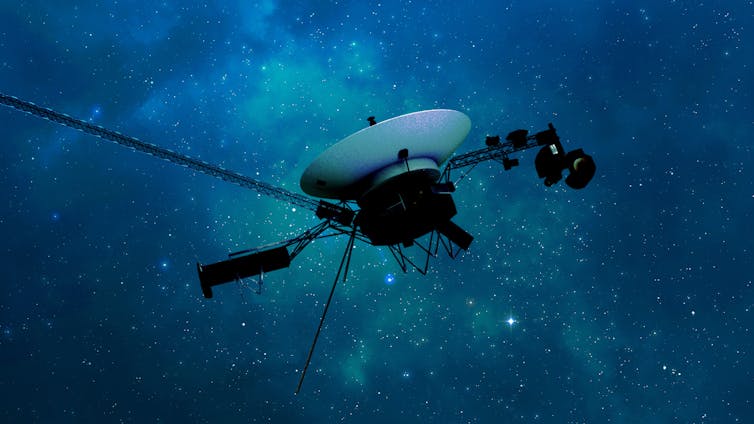Outer space is infinite, but that hasn’t stopped humans from trying to impose their laws on it. There are more ways for people to travel to space than ever before, and the next few decades are likely to see the US and China sending humans to the Moon again.
Both countries aim to set up long-term research stations on the lunar surface, a bit like there are now in Antarctica. But could disputes between these two countries – and potentially others, such as Russia or India – arise over where to locate bases on the lunar surface? And could the same happen over claims to the Moon’s resources, such as the water ice located in craters at the lunar poles?
Countries will want to extract this ice because it can be turned into rocket fuel for onward journeys and for life support at their lunar bases. Indeed, the prospect of “space water wars” is actually nearer, timewise, than the prospect of providing clean drinking water to everyone in the developing world.
But the legal arguments around rights to space water and other resources are complex. Laws are also in place to ensure countries don’t pollute bodies such as the Moon while they are exploring them.

The basic tenets of international space law are laid out in ten treaties and “soft law” agreements between multiple countries. For example, the Outer Space Treaty (1967) says that space should be “free for exploration and use by all states”, and is “not subject to national appropriation by claim of sovereignty”.
This suggests countries could be on shaky ground if they try to establish national bases on the Moon to extract water ice, as all other countries are equally entitled to explore and use that “territory”. This treaty’s stipulation that nations are free to “explore and use outer space and celestial bodies” means anyone can extract lunar resources and use them while in space.
However, there’s a potential contradiction with another part of the treaty, which allows countries to retain jurisdiction over objects they put into space – potentially implying that bases on the Moon would remain under the jurisdiction of the country that has put them there. If so, explorers from other nations might be restricted from exploring where this interferes with the jurisdiction of these bases.
The Moon Agreement, which was created in 1979 and has 17 parties including France, Australia and India, goes a bit further on resources, stating that “neither the surface nor the subsurface of the Moon, nor any part thereof or natural resources in place, shall become property of any state”. However, major spacefaring nations such as the US, Russia and China never signed this agreement.

The US has drawn up its own agreement, known as the Artemis Accords (originally signed into being in 2020), which tries to establish ground rules over the use of lunar resources such as ice. While emerging spacefaring nations including India are signatories, important space powers such as China and Russia are not.
There’s also a difference between extracting space resources such as lunar ice, which are needed for further exploration, and taking resources from space and bringing them back to Earth purely because they are financially valuable. The latter question affects the burgeoning field of asteroid mining.
A number of companies, mainly in the US and Luxembourg, have outlined plans to travel to asteroids (the leftover rocks from the birth of the solar system) and extract valuable minerals and metals, which would then be delivered back to Earth. However, it is debatable whether the repatriation of resources is allowed under the Outer Space Treaty.
Endless responsibility?
Under both the Outer Space Treaty and the UN’s Convention on International Liability for Damage Caused by Space Objects (1972), nations are liable for any destruction caused by their space hardware, and are obliged to avoid harmful contamination of space and celestial bodies. This will apply to countries that aim to extract resources on the Moon and other nearby bodies, such as Mars.
But what happens when spacecraft leave our Solar System and head to the far-off reaches of our cosmic neighbourhood? Can states still be held responsible for pollution or damage so far from Earth?
The Voyager 1 and 2 probes, launched by NASA in 1977, have already left the Solar System, and others are on trajectories that will eventually take them out of it. In the treaties it is party to, such as the Outer Space Treaty and the Liability Convention, the US appears to have agreed to continue lawful space operations endlessly into the infinity of space.
This implies that, from the design stage, scientists should configure their spacecraft and instruments in such a way that, even when not within the control of humans on Earth, they do not pollute outer space.
For example, some spacecraft use radioactive materials as power sources. The careless spread of radioactive materials would be a violation of international space law, especially where the presence of such dangerous materials is not reported to the UN bodies that oversee such matters.
Read More: Astronomers just found complex carbon molecules in space – a step closer to deciphering the origins of life
Under the Moon Agreement, there is an obligation to notify the UN before any placement of radioactive materials on the Moon, and of their purpose. But in the even that contact with a spacecraft is lost, should countries be held to their liability obligations into the infinity of space?
Space operations are fast expanding into deeper reaches of outer space. Pioneers 10 and 11, launched in the 1970s by NASA, are on trajectories that will eventually take them out of the Solar System – potentially within the next few decades. NASA’s New Horizons spacecraft passed Pluto in 2014 and is currently travelling through a distant region called the Kuiper Belt.
One answer to these legal questions is that human laws ought to logically end wherever our ability to conceptualise and carry out space operations ends. There are, for example, some good reasons to limit space law to our Solar System – because it may be impractical for states to exert control over them once they travel further, whether or not they could cause damage or pollution to more distant celestial bodies.
- is a Professor of Law, University of Bradford
- This article first appeared in The Conversation




